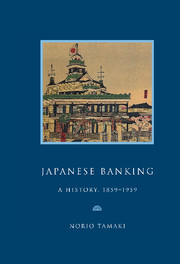Book contents
- Frontmatter
- Contents
- Preface
- Genealogy of leading Japanese banks, 1859–1959
- List of abbreviations
- Map
- Part I A bankrupt Shogunate, 1859–1868
- Part II The Meiji Restoration: monetary confusion and banking experiments, 1868–1881
- Part III Matsukata, the wizard of Japanese banking, 1881–1897; the Yokohama Specie Bank (1880) and the Bank of Japan (1882)
- Part IV The Japanese on the London money market, 1897–1911
- Part V War, the Japanese boom years, 1911–1919
- Part VI Crisis and the road to war, 1919–1937
- Part VII Complete commitment, struggle and defeat, 1937–1945
- Part VIII American ‘democratisation’ and the search for growth, 1945–1959
- Historical background
- 28 MacArthur's directives, 1945–1948
- 29 Remaking the banking system: the Japanese versus the Americans, 1946–1952
- 30 The rise of governmental banking and the search for stability: Japanese initiatives, 1949–1958
- 31 The post-war system, 1946–1959
- An extraordinary century, 1859–1959
- Appendices
- Notes
- Bibliography
- Index
28 - MacArthur's directives, 1945–1948
Published online by Cambridge University Press: 03 February 2010
- Frontmatter
- Contents
- Preface
- Genealogy of leading Japanese banks, 1859–1959
- List of abbreviations
- Map
- Part I A bankrupt Shogunate, 1859–1868
- Part II The Meiji Restoration: monetary confusion and banking experiments, 1868–1881
- Part III Matsukata, the wizard of Japanese banking, 1881–1897; the Yokohama Specie Bank (1880) and the Bank of Japan (1882)
- Part IV The Japanese on the London money market, 1897–1911
- Part V War, the Japanese boom years, 1911–1919
- Part VI Crisis and the road to war, 1919–1937
- Part VII Complete commitment, struggle and defeat, 1937–1945
- Part VIII American ‘democratisation’ and the search for growth, 1945–1959
- Historical background
- 28 MacArthur's directives, 1945–1948
- 29 Remaking the banking system: the Japanese versus the Americans, 1946–1952
- 30 The rise of governmental banking and the search for stability: Japanese initiatives, 1949–1958
- 31 The post-war system, 1946–1959
- An extraordinary century, 1859–1959
- Appendices
- Notes
- Bibliography
- Index
Summary
On 30 August 1945, that is, fifteen days after the Emperor's radio broadcast on 15 August 1945, General Douglas MacArthur, the commander-in-chief of US forces, who had a day before the Japanese surrender been appointed the Supreme Commander for the Allied Powers (SCAP), landed at Atsugi air base near Tokyo. The Allied Powers' General Headquarters, known inevitably as GHQ, which became one of the most popular western words in post-war Japan, was accommodated appropriately in the magnificent building of Daiichi Seimei, or First Life Insurance, facing the palace, the seat of the Emperor, just beyond the moat.
On 2 September, the Japanese ambassador plenipotentiary, Mamoru Shigemitsu, on board the US battleship Missouri, signed the surrender document accepting the terms of the Potsdam Declaration of 26 July 1945. From then on a series of directives started to stream out from the office of SCAP at GHQ, which, in spite of its title, in effect represented and consulted only the Washington government. As John Foster Dulles later recalled, the Japanese were unexpectedly complacent as directions poured out of MacArthur's office. The Japanese banking system was also subjected to directives from the Americans although, as will be seen, without real understanding. They could readily be outmanoeuvred.
It became a priority for the Americans to destroy the war-related monetary and banking system. On 30 September 1945, MacArthur issued the first directive on banking, stating:
1. You will immediately close and not allow to reopen, except at the direction of this headquarters, the head offices, branches and agencies in Japan of the banks and other financial institutions enumerated in Inclosure, attached thereto. […]
- Type
- Chapter
- Information
- Japanese BankingA History, 1859–1959, pp. 186 - 192Publisher: Cambridge University PressPrint publication year: 1995



